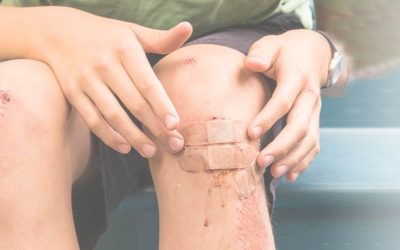Splinter Removal Made Easy
Running around barefoot on a deck sounds super fun right? Well, yes, until your two-year-old starts screaming as he got what seems like a million splinters under his feet. That was my weekend fun!
I frequently see kids in the office that need me to remove a splinter this time of year.
Well-meaning parents have often tried to remove the splinter at home with a magnifying glass and gently pull with no success, sometimes pushing the splinter further back.
If you think you can grab it quickly, go ahead and try, but I wouldn’t go fishing around in there endlessly as this can make it a deep splinter, and that is a lot more challenging to remove.
All you needed was a banana peel or duct tape to remove a splinter back in the day. Then, we would make homemade baking soda paste out of the water and baking soda and rub it in to not get infected and call it good.
Splinter Removal 101
You can try numbing the skin with a bit of ice first to make it less scary to your child. Then, try to remove the splinter ASAP to prevent infection from foreign bodies and apply rubbing alcohol to the affected area. The longer you wait (especially on the sole of the foot), the harder it is to remove. Seeing a medical professional on day 3 or 4 isn’t likely to lead to successful removal.
If you want to give it a go, here are some (somewhat evidence-based) techniques to remove a splinter:
1. Tweezers
Start with some sterilized tweezers, cleaned with soap and water, alcohol or peroxide. This is best done if you can see the edge of the splinter and you think you can grab the end easily.
2. Hydrogen peroxide
Cover the skin where the splinter is with a cotton ball or tissue soaked in hydrogen peroxide. The splinter may come to the surface. If not, at least the wound is now clean.
3. Baking soda
Make a thick paste of baking soda and water and apply to the splinter under a bandage. Leave overnight. The sliver may be out in the morning. This technique works on the theoretical fact that baking soda can cause the skin to swell, thereby pushing the splinter out.
4. Tape
Put a piece of duct tape against the skin where the splinter is. It may be strong enough to adhere to the splinter and pull it out when you remove the tape. This will only work if the splinter edge is at the skin surface.
5. Egg
Break an egg and place the inside of the shell (the wet side) against the skin where the splinter is. The shell may allow the splinter to work its way out of the skin (I have no idea how).
6. Pantyhose
This works excellent for splinters or thorns with small edges. Place a piece of pantyhose against the skin to snag the edge and gently pull.
7. Tomato, Onion, or Potato
A slice of tomato, potato, or onion placed against the skin may bring the splinter to the surface. If you successfully remove the splinter, please clean the affected area with soap and water to prevent infection.
Academic research institutions warn about splinters, although they’re small, this is an open wound and would benefit from simple wound care, covering for a day or two to prevent debris and other foreign bodies from entering and causing infection.
In addition, covering with a small amount of antibiotic ointment may help speed wound healing and avoid infection.
FAQs
Q: Can I Remove a Splinter with Baking Soda?
A: Yes, you can. When the splinter is too deep, and you don’t want to poke around with
tweezers or a needle, you can use baking soda. It will increase osmotic pressure on the
skin, thus pushing the splinter up for easy removal. However, you have to be patient. Once
you apply the baking soda and water paste to the spot, you have to cover it and leave it on
for 24 hours before you can remove the splinter.
Q: What Happens When you Don’t Take out a Splinter?
A: A splinter is a foreign body, so your body will naturally push it out if you don’t take it out yourself. It won’t be absorbed or broken down, so it will eventually come out.
However, it’s recommended you take the splinter out as soon as you can to avoid swelling and redness.
Q: How do Doctors Remove Splinters?
A: If your splinter is too deep and you can’t get to it, you may have to go to the doctor.
They will numb the area and make a small incision with a scalpel to remove it. If the
splinter is under a fingernail; they will have to remove a part of the nail to get the splinter
out.
Q: Can a Splinter Cause Infections?
A: Yes, if you don’t take the splinter out, it can cause infection. The splinter itself can be
carrying bacteria and fungi, not to mention it creates an entry point for microbes. You know
your splinter is infected if the skin around it is red or hardened, or if there’s white or yellow
discharge, a.k.a pus.
Q: Can an ingrown toenail go away?
A: No, an ingrown toenail will not disappear without help. It requires treatment, and if you
fail to do that, it can cause infections and other issues.
Q: What is an ingrown toenail?
A: An ingrown toenail is when the nail continues growing to the side, into the skin that
surrounds your toe. This causes pain, swelling, and redness. Big toes are the most
commonly affected.
Q: How to Care for an Ingrown Toenail?
A: You can care for an ingrown toenail in many different ways. For one, you can apply
antibiotic cream and bandage it. You can give your feet a warm water soak for up to 20
minutes and then put some cotton or dental floss under the ingrown toenail to get it to
grow above the skin. It’s also recommended to use sensible, open-toe shoes, and you can
take a pain reliever if you need it.
Q: Can Ingrown Toenails Cause Swelling?
A: Yes, ingrown toenails can cause swelling, which is one of the main reasons you should
get it treated ASAP. You can care for it at home, but if nothing you do helps, you need to
go to the doctor. They will provide the best treatment option for your particular case, and
you’ll get the relief you’re looking for.

Click here to read about playground safety and how to prevent such injuries, or read about how we close wounds.










